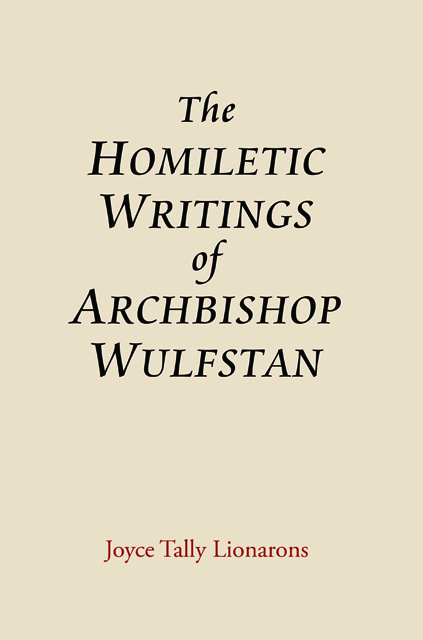Book contents
- Frontmatter
- Contents
- Acknowledgements
- Abbreviations
- Manuscript Sigla
- Introduction
- 1 Wulfstan and Wulfstan Manuscripts
- 2 Re-establishing the Wulfstanian Homiletic Canon
- 3 Wulfstan’s Eschatology
- 4 Salvation History and Christianity
- 5 Wulfstan as Archbishop
- 6 Sacramental Sermons
- 7 The Danish Invasions and the Sermo Lupi ad Anglos
- 8 Homilies Based on Legal Codes and the Institutes of Polity
- Bibliography
- Index
- Miscellaneous Endmatter
7 - The Danish Invasions and the Sermo Lupi ad Anglos
Published online by Cambridge University Press: 18 February 2023
- Frontmatter
- Contents
- Acknowledgements
- Abbreviations
- Manuscript Sigla
- Introduction
- 1 Wulfstan and Wulfstan Manuscripts
- 2 Re-establishing the Wulfstanian Homiletic Canon
- 3 Wulfstan’s Eschatology
- 4 Salvation History and Christianity
- 5 Wulfstan as Archbishop
- 6 Sacramental Sermons
- 7 The Danish Invasions and the Sermo Lupi ad Anglos
- 8 Homilies Based on Legal Codes and the Institutes of Polity
- Bibliography
- Index
- Miscellaneous Endmatter
Summary
WULFSTAN's RESPONSE to the Viking invasions did not, of course, end with the penitential edict of 1009. To further underscore the need for radical penance on both an individual and communal basis, Wulfstan turned to the Old Testament and the tribulations of the Israelites to find a precedent for the sufferings of the English and the remedy for such suffering in penitential actions. One of the earliest of Wulfstan's writings to make use of the Old Testament analogy is a series of Latin excerpts from Isaiah and Jeremiah, followed by English translations and supplemented by a few commonplace homiletic sentiments. Incipit de visione Isaie prophete quam vidit super Iudam et Heirusalem (‘Here begins the vision seen by the prophet Isaiah concerning Judah and Jerusalem’; Bethurum XI; Napier 6) survives in three manuscripts. The full text is extant only in E; in C the text breaks off in the middle of the last translation from Jeremiah owing to a missing page in the manuscript, while in Cop the Latin text survives only up to the penultimate quotation from Jeremiah. The De visione Isaie immediately precedes De septiformi spiritu in both C and E, following the Sermo de baptismate in E and Her onginneð be cristendome in C. In Cop, the Latin quotations are followed by a homiletic fragment in Wulfstan's handwriting that begins with a sentence linking the fragment to the quotation from Jeremiah. As noted in Chapter 2, Wulfstan added to the fragment at least once and possibly twice, suggesting that although Wulfstan apparently never revised his translations into a fully structured homily, he continued to toy with the idea of composing a sermon based on the quotations.
Bethurum prints the De visione Isaie among the catechetical homilies, despite the fact that it is neither structured as a homily nor especially catechetical; Thomas Hall has somewhat generously suggested that the reason for its inclusion lies in the De visione Isaie's importance for the study of Wulfstan's prose style, which is exceptionally alliterative and rhythmic in this work. Bethurum speculates that Wulfstan chose the excerpts and made the translations relatively early in his career, perhaps as an ‘exercise in rhythmical composition’ before he settled into his mature style; Patrick Wormald's chronology, in contrast, places the De visione Isaie somewhat later, perhaps between 1009 and 1014, and certainly the content of the translations would make these dates seem more fitting.
- Type
- Chapter
- Information
- The Homiletic Writings of Archbishop WulfstanA Critical Study, pp. 147 - 163Publisher: Boydell & BrewerPrint publication year: 2010



